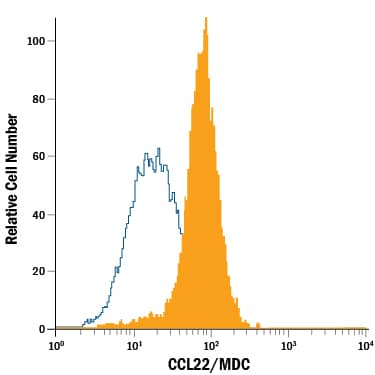Human CCL22/MDC PE-conjugated Antibody
R&D Systems, part of Bio-Techne | Catalog # IC3361P


Key Product Details
Validated by
Species Reactivity
Validated:
Cited:
Applications
Validated:
Cited:
Label
Antibody Source
Product Specifications
Immunogen
Gly25-Gln93
Accession # O00626.1
Specificity
Clonality
Host
Isotype
Scientific Data Images for Human CCL22/MDC PE-conjugated Antibody
Detection of CCL22/MDC in Human Dendritic Cells by Flow Cytometry.
Human dendritic cells treated with LPS, Recombinant Human TNF-a (Catalog # 210-TA), and Recombinant Human IL-1 beta/IL-1F2 (Catalog # 201-LB) were stained with Mouse Anti-Human CCL22/MDC PE-conjugated Monoclonal Antibody (Catalog # IC3361P, filled histogram) or isotype control antibody (Catalog # IC0041P, open histogram). To facilitate intracellular staining, cells were fixed with Flow Cytometry Fixation Buffer (Catalog # FC004) and permeabilized with Flow Cytometry Permeabilization/Wash Buffer I (Catalog # FC005). View our protocol for Staining Intracellular Molecules.Applications for Human CCL22/MDC PE-conjugated Antibody
Intracellular Staining by Flow Cytometry
Sample: Human dendritic cells treated with LPS, Recombinant Human TNF‑ alpha (Catalog # 210-TA), and Recombinant Human IL‑1 beta/IL‑1F2 (Catalog # 201-LB) were fixed with Flow Cytometry Fixation Buffer (Catalog # FC004) and permeabilized with Flow Cytometry Permeabilization/Wash Buffer I (Catalog # FC005)
Reviewed Applications
Read 1 review rated 5 using IC3361P in the following applications:
Formulation, Preparation, and Storage
Purification
Formulation
Shipping
Stability & Storage
- 12 months from date of receipt, 2 to 8 °C as supplied.
Background: CCL22/MDC
CCL22, also named stimulated T cell chemotactic protein (STCP-1), is a CC chemokine initially isolated from clones of monocyte-derived macrophages. Human CCL22 cDNA encodes a precursor protein of 93 amino acid residues with a 24 amino acid residue predicted signal peptide that is cleaved to yield a 69 amino acid residue mature 8 kDa protein. At the amino acid sequence level, CCL22 shows less than 35% identity to other CC chemokine family members. Human CCL22 is expressed in dendritic cells, macrophages and activated monocytes. In addition, CCL22 expression is also detected in the tissues of thymus, lymph node and appendix. The gene for human CCL22 has been mapped to chromosome 16 rather than chromosome 17 where the genes for many human CC chemokines are clustered. Recombinant or chemically synthesized mature CCL22 has been shown to induce chemotaxis or Ca2+ mobilization in dendritic cells, IL-2 activated NK cells, and activated T lymphocytes. A CD8+ T lymphocyte-derived secreted soluble activity that suppresses infection by primary non-syncytium-inducing and syncytium-inducing HIV-1 isolates and the T-cell line-adapted isolate HIV-1IIIB, has been identified as CCL22. Based on amino-terminal sequence analysis, the major CD8+ T lymphocyte-derived CCL22 protein yielded an amino-terminal sequence of YGANM, which is two amino acid residues shorter than the predicted mature CCL22. The difference in potency between the two mature CCL22 isoforms has not been determined.
References
- Godiska, R. et al. (1997) J. Exp. Med. 185:1595.
- Chang, M-S. et al. (1997) J. Biol. Chem. 272:25229.
- Pal, R. et al. (1997) Science 278:5338.
Alternate Names
Gene Symbol
UniProt
Additional CCL22/MDC Products
Product Documents for Human CCL22/MDC PE-conjugated Antibody
Product Specific Notices for Human CCL22/MDC PE-conjugated Antibody
For research use only